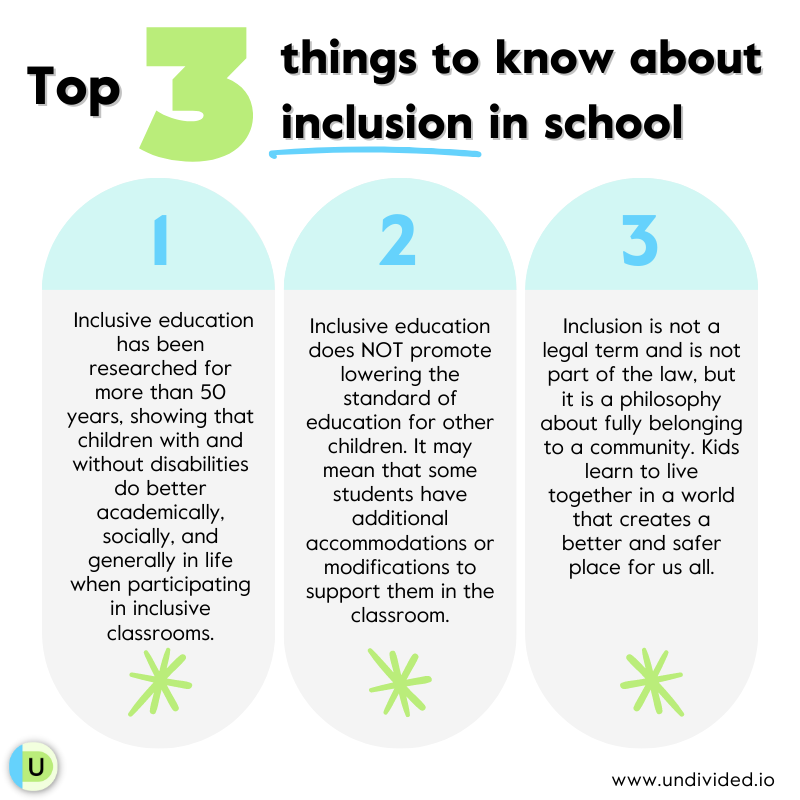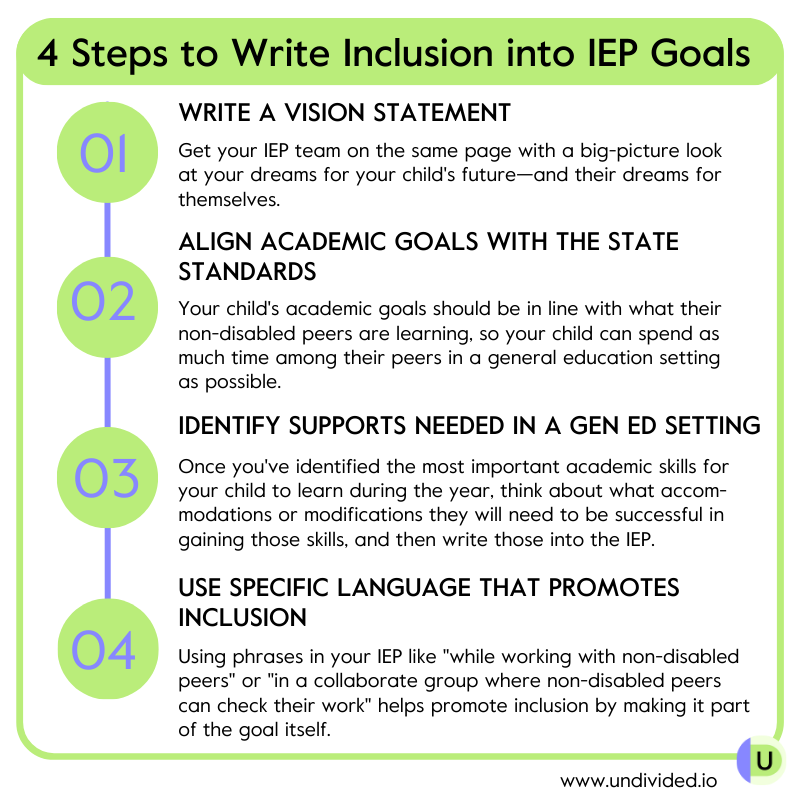Inclusion 101
Inclusion is the process of changing the school environment so that a student with unique challenges can be successful. The idea of inclusion is not limited to disability — we also practice inclusion when we make accommodations to ensure that people from different cultural, economic, and other backgrounds are given equal opportunities in society. While inclusion is not limited to school environments, this article focuses on the basics of inclusive education for children with disabilities.
What is inclusion?
Inclusive programs can take many forms.
Partial inclusion models:
- In mainstreaming, a student spends some portion of their day in a separate special education (SpEd) class as well as in their general education (GenEd) class.
- In learning center models, a student with a GenEd placement is pulled out to a resource room or learning center for part of the day.
Full inclusion models:
- A student is placed in GenEd for 80% or more of the school day, and special education services are provided in the classroom (“pushed in”).
- SpEd support is often provided for students by:
- An inclusion facilitator (an itinerant SpEd teacher) working in consultation with the GenEd teacher
- Co-taught models, where the class has two teachers (one SpEd and one GenEd) working together
Effective full inclusion gives the student a sense of belonging and being a valued member of the classroom community. Inclusion also ensures that children have access to history, poetry, team sports, theater and arts programs, model UN, and more, in addition to the core curriculum.
An important component of inclusive education is that students have access to grade-level content. However, this does not mean that students need to be at grade level; accommodations can be provided to the student, and the curriculum can also be modified to a different but related standard using the same subject matter.
For example, in English Language Arts, a student who is not at grade level with reading might be given accommodations to allow them to study the same novel as their peers by providing them with an audiobook, speech-to-text software, and/or a scribe. A student who is not at grade level with math can be provided with accommodations such as manipulatives, a calculator, a times table, and other supports.
If students are studying a novel, a student with modifications might read a simplified text of the same story and answer “who/where/what” questions while the other students focus on “why” questions. In science, students might be studying how the environment influences differences in organisms using material about lizards; a student with a modified curriculum could work on naming differences such as size, color, and pattern using the same lizards.
The law is very clear that the need for modified curriculum is not a reason to exclude a child from a GenEd classroom. Modifications can be provided to the teacher by a specialist or the co-teacher. If an IEP team determines that the student needs alternative state testing, this is also not a reason for a more restrictive placement. The SpEd teacher can provide modifications based on the Core Content Connectors that simplify state standards for students who need modifications. Unfortunately, many GenEd teachers are not adequately trained in the use of Core Content Connectors.
What inclusion isn’t
Inclusion does not mean “dumping” a student in GenEd. Students need to receive individualized supports to be successful. A huge variety of supports can be offered, including a 1:1 aide, assistive technology, and behavior support, and services such as speech and occupational therapy can be pushed in.
The why of inclusion
Inclusion expert Carol Quirk says, “If it’s not working, it’s not inclusion.” This makes sense if we think of inclusion as the supports we put in place to make education accessible to everyone. For more than forty years, educationalists have been publishing research to show that students do better in inclusive settings; these experts want to improve the inclusion process because learning alongside nondisabled children and belonging in one’s natural community is a matter of social justice.
Inclusion is the central purpose of special education. The Individuals with Disabilities Education Act (IDEA) — the federal law that entitles every child with a disability to a free and appropriate public education — makes it clear that the purpose of special education is to make it possible for individuals with disabilities to be included in our society, in employment, and in cultural and civic life; to do so, they need an education.
You may have heard the phrase “You can’t learn to swim in a parking lot.” What this means is that people learn new skills best when they are taught in context. It would be much safer to teach children to swim in a parking lot before they go near a pool where they could drown, but we all know they will not really learn how to swim until they get in the water. Many studies indicate that most individuals learn best when they are able to interact with others who are also learning, and providing necessary supports is key.
What does the research say about inclusion?
Research shows that inclusive education is linked to better academic results, employment in competitive integrated work, and other indicators of success. Research also shows that children in inclusive placements have more ambitious IEP goals. In 2004, inclusion expert Mary Falvey and colleagues reviewed hundreds of research studies and were “unable to identify even a single research article that found that segregated service delivery models are more effective than integrated models for students with severe disabilities.”
In 2011, a study on “self-contained” classrooms examined the reasons that have sometimes been used to claim that special day classrooms (SDCs) might be better for students with disabilities. (For example, “A self-contained classroom creates a sense of community and is better able to provide specialized support, individualized curriculum, and/or a distraction-free environment”). The researchers observed six self-contained classrooms that were proposed by their districts as a good example of this model and found that none of the classrooms delivered on any of these claims.
A 2020 study grouped children with high support needs from one school district into 15 pairs, matched by disability and skill level. One student in each pair attended a separate class or SpEd school, and the other was fully included (in GenEd at least 80% of the time). The researchers observed the children during the day and noted what they were engaged in and the number of interactions they had with peers and adults. Sometimes, the researcher was not able to describe the activity that the student in the separate class or school was engaged in, and many of the social interactions were recorded as zero. The children included in GenEd had far more social interactions during their day. When researchers compared academic performance and progress on IEP goals, they found a significant difference in favor of the fully included students.
It’s important to note that within the Deaf and hard-of-hearing (DHH) community, there are some very different perspectives on inclusion. The DHH community believes that a GenEd setting is restrictive for DHH children because it is limited to acoustic language. (There is also some research to support this.) For children with DHH eligibility, the least restrictive environment is one where ASL is used by both teachers and students. This can be combined with GenEd in an inclusive program.
What does the law say about inclusion?
Before 1972, when two court cases (PARC v. Commonwealth of Pennsylvania and Mills v. Board of Education of the District of Columbia) paved the way for the Education for All Handicapped Children Act of 1975 (which later became IDEA), millions of children with disabilities were either not welcome in public school or given no accommodations or support to help them thrive. The purpose of the 1975 law was to give children with disabilities equal access to public education, drawing on the principle from 1954’s Brown v. Board of Education that “separate was inherently unequal.” For this reason, the law contains a strong preference for inclusion in GenEd.
Least restrictive environment (LRE) and inclusion
IDEA’s “least restrictive environment” (LRE) concept states that:
To the maximum extent appropriate, children with disabilities should be educated with children who are nondisabled in public or private institutions or other care facilities.
Special classes, separate schooling, or other removal of children with disabilities from the regular educational environment should occur only if the nature or severity of the disability is such that education in regular classes with the use of supplementary aids and services cannot be achieved satisfactorily.
In this clip, Dr. Caitlin Solone, education advocate, teacher-educator, and administrator for the Disability Studies program at UCLA, explains a common misconception of children with disabilities in general education classrooms.
Check out The 5 Biggest Myths About Inclusion to hear more from Dr. Solone about correcting misconceptions that parents, teachers, and school administrators may have about including kids with disabilities in GenEd.
IEP teams must consider GenEd placement, and whether more supports or services could be provided to make the placement successful. The law says that IEP teams should choose a placement that is as close as possible to the child’s home so that the child is educated in the school they would attend if they were nondisabled (unless their IEP requires some other arrangement). The same paragraph states that a child with a disability should not be “removed from education in age-appropriate regular classrooms solely because of needed modifications in the general education curriculum.”
Districts handle inclusion differently
Lawmakers clearly intended to maximize inclusion, but the “least restrictive environment” concept is open to broad interpretation, and the courts have not always stood by parents seeking inclusion where the district says there is no educational benefit. Dina Kaplan, an attorney at Vanaman German LLP, told us, “Each school district handles inclusion a little differently.” For example, her firm is challenging LAUSD cases of children who are able to work on the GenEd curriculum but can’t access inclusion support (an inclusion facilitator), which is a privilege restricted to students on the LAUSD alternate curriculum path. In other districts, inclusion support isn’t even offered as a service.
Kaplan explains that the courts weigh the balance between the requirement to educate children with their nondisabled peers and the primary IDEA responsibility to create an IEP that is reasonably calculated to offer an educational benefit. She argues that if a child has access to a modified curriculum and accommodations in GenEd, then placement will not usually matter when it comes to the question of educational benefit. In other words, it is possible to have both.
What's the reality?
Given the strong case for inclusion, you might expect it to be the norm. However, most children with extensive support needs spend little time in GenEd settings. For example, in California, only 59% of all children with IEPs ages six to twenty-two are fully included. The majority of IEP students are eligible for SpEd because of a specific learning disability (SLD) or a speech and language disability, and these groups have high rates of inclusion. Looking at smaller groups such as autism (36% fully included), intellectual disability (8%), or multiple disabilities (5%), many students are partially included, spending 40% or more of their day in a GenEd setting, but large numbers spend less than 40% in GenEd; this could be PE or lunch, or it could reflect no interaction with nondisabled peers. This is much lower than national averages. Even at the state level, there is a lot of variation depending on which school district you live in.
Parent advocacy can help change this reality. In this clip, Dr. Solone explains how the push for inclusion can create a better environment, not only for your child but for all children.
How to write inclusion into your IEP
When discussing services, ask if it’s possible for the service to be provided in the GenEd setting as push-in, meaning that it occurs in the GenEd classroom. If it has to be pull-out, ask if it’s possible to be provided outside the regular school day to minimize disruption to GenEd time. Pay attention to IEP goals that need a lot of intensive 1:1 work because your child will likely get pulled out.
In the absence of a co-teacher or inclusion specialist, consider whether special academic instruction (SAI) could be provided as a consultation with the GenEd teacher. You can also write access to an inclusion specialist into your IEP, as Dr. Sarah Pelangka explains in this clip:
Make sure your child is receiving the accommodations they need to be successful in a GenEd classroom. Common accommodations to support inclusion include a 1:1 aide, an inclusion facilitator, access to modified curriculum, assistive technology (such as audiobooks, predictive text, and text to speech/speech to text), chapter summaries, shortened assignments, pre-teaching vocabulary and concepts, and much more.
Placement is an important part of your child’s IEP; be sure to express concerns while reviewing their present levels that include access to nondisabled peers and GenEd curriculum. Ask if skills that your child mastered in pull-out speech or occupational therapy are generalized when in a GenEd setting.
When identifying goals, consider whether you can ask to rewrite the goal to include “with a same-age typical peer” as part of the activity. Encourage your IEP team to identify goals that promote interaction with other students. Always ensure that the goals are tied to the Common Core State Standards or the Core Content Connectors. In this clip, Dr. Solone explains how these standards-based goals can be used to encourage inclusion in the classroom.
Make sure to follow up on parts of the IEP intended to facilitate inclusion. We have a checklist of questions you can ask your IEP team to assess how your child is being included in the classroom and other school activities.
What to do if you get pushback
Knowing that many teachers still believe students with intellectual disability cannot be included in GenEd settings, many families refuse IQ testing and instead ask for an eligibility category of Other Health Impairment. Legally, however, there should be no connection between eligibility and placement.
If your school district is not supportive of inclusion, you can use the law to insist on placement in GenEd — but without support from the school, your child might not be as successful. Often, the district will say that the expertise your child needs is located in a self-contained class. Many families choose self-contained classes for this reason. However, all services should be portable, so you can ask for the expertise to be brought to your child in their GenEd classroom.
Many families feel that a 1:1 aide is necessary to make inclusion work for their child. They may be told that this is “more restrictive.” However, if the aide provides the support the child needs to stay in GenEd, having an aide is less restrictive than a self-contained class.
If your school does not offer an inclusion class, inclusion facilitators, or co-teachers, it might be helpful to request that a non-public agency (NPA) inclusion expert consult with the IEP team and troubleshoot support options.
Inclusion in both GenEd classrooms and extracurricular activities can help your child have more opportunities to socialize with peers and develop important skills. Check out our article Socialization and Inclusion: Nurturing Authentic Peer Relationships for answers to some common questions about helping our kids make friends of all abilities. You can also check out Socialization Goals in the IEP for examples of supporting inclusion with IEP goals.
Join for free
Save your favorite resources and access a custom Roadmap.
Get StartedAuthor





Socialization and inclusion